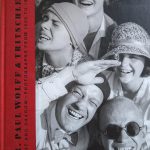Photography in Frankfurt am Main in the 1920s. Dr. Paul Wolff’s booth at the “German Photographic Exhibition” – the Deutsche Photographische Ausstellung. Wolff’s work with Fried Lübbecke on collecting photographs for an exhibition by Frankfurt’s Alliance of Working Old-Town Friends.Photography in Frankfurt am Main in the 1920s Deutsche Photographische Ausstellung Bund tätiger Alstadtfreunde 1920s photography in Frankfurt am Main Centralverband Deutscher Photographenvereine und Innungen Alfred Tritschler Otto Ernst Sutter
Dr. Paul Wolff & Tritschler. Light and Shadow – Photographs from 1920 to 1950. © 2019 Kehrer Verlag Heidelberg Berlin, authors, artists and photographers [and translator]. ISBN 978-3-86828-881-0
Published at Kehrer Verlag. Editor Hans-Michael Koetzle. Translator Alexandra Cox. The respective word count in the book is indicated for each essay (for reasons of concision, I omit the endnotes, but they are included in the word count). Picture books on Old Frankfurt Photobooks on Old Frankfurt
From: Photographer of Old and New Frankfurt.
Deutsche Photographische Ausstellung
Photography in Frankfurt am Main in the 1920s
Paul Wolff between Convention and Avant-Garde.
by Sabine Hock. Translated from German by Alexandra Cox.
9,896 words
“Back to Photography” Photography in Frankfurt am Main in the 1920s
In late summer 1926, from August 14 through September 1, the “German Photographic Exhibition” took place in Frankfurt am Main. At this industrial exhibition, organized by the Messe- und Ausstellungsgesellschaft in conjunction with the “Centralverband Deutscher Photographenvereine und Innungen” (central association of German photographer clubs and guilds), all fields of photography, including industry, trade and professional schools, presented themselves in two halls on the trade show complex. According to the exhibitor directory, Paul Wolff was represented with a booth in the “professional photography” group, with a closer description of his area of business: “Photographic and film recordings. Promotional films. Slow motion recordings. Photography at the service of transit advertising.” Fried Lübbecke, a participant in the trade show’s organization as an employee of the department for advertising and exhibition organization at the municipal Office of Economic Affairs, under councilor Peter Schlotter (1879–1958) and trade fair director Otto Ernst Sutter, was a fellow member of the working committee at the “Department of Scientific Photography”; in addition, he was responsible for the exhibition, held by the Alliance of Working Old-Town Friends, “Old Frankfurt in Photography. Vanished Buildings, Faded Festivities, Passed-away People”. In his memoirs, Lübbecke recalls that Wolff helped him “in collecting old photos for a historical show at the exhibition”. According to Lübbecke’s account, the City of Frankfurt allegedly paid for a Leica for Wolff as a reward for his engagement, whereas Wolff himself writes multiple times that his first Leica came courtesy of a chance win at that Frankfurt exhibition. Neither of these versions can be proven. However, it is undisputed that Wolff was in possession of a Leica from 1926.
The film business was still going well. In 1927, Paul Wolff had so much to do that he recruited his first employee, the trained photographer Alfred Tritschler (1905–1970), who had responded to Wolff’s job advertisement in a trade journal and was experienced in both photography and film.
The New Frankfurt housing development project ran under the direction of architect Ernst May from 1925 until 1930. Dr. Paul Wolff photographed some of the approximately 15,000 homes that were built during those years; click on the poppy below for more from:
Dr. Paul Wolff & Tritschler. Light and Shadow. Publisher Kehrer Verlag. Editor Hans-Michael Koetzle. Translator Alexandra Cox
